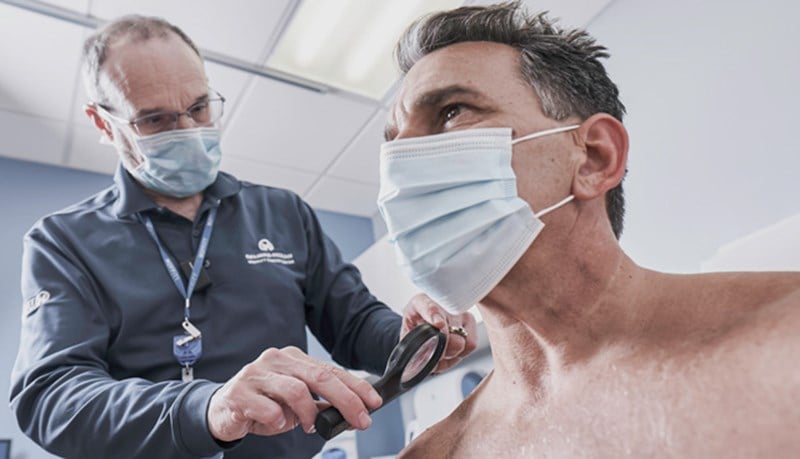What is Merkel Cell Carcinoma?
Merkel cell carcinoma is a relatively uncommon form of skin cancer that results from the excessive growth of cells that serve as touch receptors (Merkel cells) in the outermost layer of the skin. For reasons still under investigation within the scientific community, Merkel cell carcinoma often develops on areas of the body that are regularly exposed to natural or artificial sources of ultraviolet (UV) light, such as sunlight and tanning beds. For this reason, researchers believe UV exposure plays a role in its development.

Does Merkel cell carcinoma run in families?
Evidence suggests that Merkel cell carcinoma does not run in families. Instead, the cellular DNA changes that cause it most likely to take place during the course of a person’s lifetime. In some cases, the DNA changes are random events that cannot be attributed to any specific cause.
What are the risk factors for Merkel cell carcinoma?
Individuals who have fair skin, and those who are age 50 or older, are at heightened risk of developing Merkel cell carcinoma. Other risk factors include:
Unprotected exposure to UV light
UV radiation can damage the DNA of skin cells. The damage can affect the genes that control how and when the cells grow and divide, sometimes causing rapid and uncontrolled cellular growth that ultimately leads to the development of skin cancer. Usually, Merkel cell carcinoma first appears as a single, painless lump on sun-exposed skin.
UV exposure also has other harmful effects on the body that can eventually lead to the development of many types of cancer, including Merkel cell carcinoma. For instance, UV radiation can suppress the body’s immune system, rendering it less effective at targeting and destroying cancer, viruses and other harmful invaders.
A weakened immune system
In addition to UV exposure, immunosuppression can result from certain medical conditions, such as human immunodeficiency virus (HIV) and certain types of cancer, including lymphoma and chronic lymphocytic leukemia. Furthermore, immunosuppressant medications are often prescribed for individuals who are diagnosed with an autoimmune disease, such as rheumatoid arthritis, lupus, psoriasis or Crohn’s disease, as well as for patients who undergo organ transplantation.
A history of skin cancer
Individuals who have had another type of skin cancer that is frequently associated with UV exposure—such as basal cell carcinoma, Bowen’s disease, squamous cell carcinoma or melanoma—are more likely to develop Merkel cell carcinoma.
Merkel cell polyomavirus
A common skin virus, Merkel cell polyomavirus infections are typically benign and asymptomatic. In rare instances, a Merkel cell polyomavirus infection can cause abnormal cellular growth that leads to the development of Merkel cell carcinoma. Because Merkel cell polyomavirus is very common and Merkel cell carcinoma is very rare, researchers are continuing to investigate how and why the virus sometimes becomes cancerous.
Merkel cell carcinoma stages
After diagnosing Merkel cell carcinoma, a physician will assess how far the cancer has progressed through a complex process known as staging. The stage of the tumor at the time of diagnosis is a key factor in determining the optimal treatment options as well as the likelihood of further cancer spread (metastasis). In general, the lower the number, the less the cancer has spread.
Stage 0
The tumor has not advanced beyond the outermost layer of skin. Stage 0 is also referred to as carcinoma in situ, which means “cancer in its original place.”
Stages 1 & 2
The tumor has not spread to nearby lymph nodes. Stage I includes tumors smaller than 2 centimeters in diameter, and stage 2 includes larger tumors.
Stage 3
Cancer cells have traveled outside the original tumor and spread into nearby lymph nodes, but not beyond the lymph nodes.
Stage 4
Cancer cells have entered the lymphatic system or bloodstream and spread to distant lymph nodes, organs and tissues.
Moffitt’s approach Merkel cell carcinoma treatment
The comprehensive Cutaneous Oncology Program at Moffitt Cancer Center is dedicated to the treatment of Merkel cell carcinoma and other forms of skin cancer. In a single location, we offer all aspects of prevention, screening, diagnosis, staging, treatment, support and long-term follow up. Our multispecialty team consists of a broad range of experienced skin cancer specialists, including:
- Fellowship-trained surgeons
- Medical oncologists
- Dermatologists
- Dermatopathologists
- Radiologists
- Radiation oncologists
- Plastic surgeons
- Supportive care specialists
These experts collaboratively develop an individualized treatment plan for each patient, then monitor the patient’s progress to ensure the best possible outcome and quality of life.
The nationally acclaimed research team at Moffitt continues to learn more about Merkel cell carcinoma every day, and we take a bench-to-bedside approach to make the benefits of our laboratory breakthroughs available to our patients as quickly as possible. Moffitt is the only National Cancer Institute-designated Comprehensive Cancer Center based in Florida, which is a testament to our extensive research and consistent progress.
For these reasons and others, Moffitt is redefining how Merkel cell carcinoma is diagnosed and treated. To learn more, call 1-888-663-3488 or request an appointment by completing a new patient registration form online.
